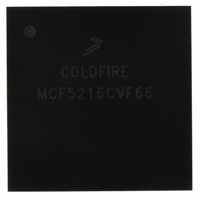MCF5216CVF66 Freescale Semiconductor, MCF5216CVF66 Datasheet - Page 635

MCF5216CVF66
Manufacturer Part Number
MCF5216CVF66
Description
IC MPU 32BIT COLDF 256-MAPBGA
Manufacturer
Freescale Semiconductor
Series
MCF521xr
Datasheet
1.MCF5216CVM66J.pdf
(766 pages)
Specifications of MCF5216CVF66
Core Processor
Coldfire V2
Core Size
32-Bit
Speed
66MHz
Connectivity
CAN, EBI/EMI, I²C, SPI, UART/USART
Peripherals
DMA, LVD, POR, PWM, WDT
Number Of I /o
142
Program Memory Size
512KB (512K x 8)
Program Memory Type
FLASH
Ram Size
64K x 8
Voltage - Supply (vcc/vdd)
2.7 V ~ 3.6 V
Data Converters
A/D 8x12b
Oscillator Type
Internal
Operating Temperature
-40°C ~ 85°C
Package / Case
256-MAPBGA
Controller Family/series
ColdFire
Ram Memory Size
64KB
Embedded Interface Type
CAN, I2C, SPI, UART
No. Of Pwm Channels
8
Operating Temperature Range
-40°C To +85°C
No. Of Pins
256
Rohs Compliant
No
Package
256MA-BGA
Device Core
ColdFire
Family Name
MCF521x
Maximum Speed
66 MHz
Operating Supply Voltage
3.3 V
Data Bus Width
32 Bit
Number Of Programmable I/os
142
Interface Type
QSPI/UART/I2C/CAN
On-chip Adc
8-chx10-bit
Number Of Timers
8
Lead Free Status / RoHS Status
Contains lead / RoHS non-compliant
Eeprom Size
-
Available stocks
Company
Part Number
Manufacturer
Quantity
Price
Company:
Part Number:
MCF5216CVF66
Manufacturer:
FSC
Quantity:
1 670
Company:
Part Number:
MCF5216CVF66
Manufacturer:
Freescale Semiconductor
Quantity:
10 000
Part Number:
MCF5216CVF66
Manufacturer:
FREESCALE
Quantity:
20 000
Company:
Part Number:
MCF5216CVF66J
Manufacturer:
Freescale Semiconductor
Quantity:
10 000
- Current page: 635 of 766
- Download datasheet (9Mb)
The assertion of BKPT should be considered in the following two special cases:
CSR[27–24] indicates the halt source, showing the highest priority source for multiple halt conditions.
Freescale Semiconductor
1. A catastrophic fault-on-fault condition automatically halts the processor.
2. A hardware breakpoint can be configured to generate a pending halt condition similar to the
3. The execution of a HALT instruction immediately suspends execution. Attempting to execute
4. The assertion of the BKPT input is treated as a pseudo-interrupt; that is, the halt condition is
•
•
assertion of BKPT. This type of halt is always first made pending in the processor. Next, the
processor samples for pending halt and interrupt conditions once per instruction. When a pending
condition is asserted, the processor halts execution at the next sample point. See
“Theory of
HALT in user mode while CSR[UHE] = 0 generates a privilege violation exception. If
CSR[UHE] = 1, HALT can be executed in user mode. After HALT executes, the processor can be
restarted by serial shifting a
instruction after HALT.
postponed until the processor core samples for halts/interrupts. The processor samples for these
conditions once during the execution of each instruction. If there is a pending halt condition at the
sample time, the processor suspends execution and enters the halted state.
After the system reset signal is negated, the processor waits for 16 processor clock cycles before
beginning reset exception processing. If the BKPT input is asserted within eight cycles after RSTI
is negated, the processor enters the halt state, signaling halt status (0xF) on the PST outputs. While
the processor is in this state, all resources accessible through the debug module can be referenced.
This is the only chance to force the processor into emulation mode through CSR[EMU].
After system initialization, the processor’s response to the
BDM commands performed while it is halted for a breakpoint. Specifically, if the PC register was
loaded, the
address in the PC, bypassing normal reset exception processing. If the PC was not loaded, the
command causes the processor to exit halted state and continue reset exception processing.
The ColdFire architecture also handles a special case of BKPT being asserted while the processor
is stopped by execution of the STOP instruction. For this case, the processor exits the stopped mode
and enters the halted state, at which point, all BDM commands may be exercised. When restarted,
the processor continues by executing the next sequential instruction, that is, the instruction
following the STOP opcode.
GO
Operation.”
command causes the processor to exit halted state and pass control to the instruction
MCF5282 and MCF5216 ColdFire Microcontroller User’s Manual, Rev. 3
GO
command into the debug module. Execution continues at the
GO
command depends on the set of
Section 30.6.1,
Debug Support
30-17
GO
Related parts for MCF5216CVF66
Image
Part Number
Description
Manufacturer
Datasheet
Request
R
Part Number:
Description:
Manufacturer:
Freescale Semiconductor, Inc
Datasheet:
Part Number:
Description:
Manufacturer:
Freescale Semiconductor, Inc
Datasheet:
Part Number:
Description:
Manufacturer:
Freescale Semiconductor, Inc
Datasheet:
Part Number:
Description:
Manufacturer:
Freescale Semiconductor, Inc
Datasheet:
Part Number:
Description:
Manufacturer:
Freescale Semiconductor, Inc
Datasheet:
Part Number:
Description:
Manufacturer:
Freescale Semiconductor, Inc
Datasheet:
Part Number:
Description:
Manufacturer:
Freescale Semiconductor, Inc
Datasheet:
Part Number:
Description:
Manufacturer:
Freescale Semiconductor, Inc
Datasheet:
Part Number:
Description:
Manufacturer:
Freescale Semiconductor, Inc
Datasheet:
Part Number:
Description:
Manufacturer:
Freescale Semiconductor, Inc
Datasheet:
Part Number:
Description:
Manufacturer:
Freescale Semiconductor, Inc
Datasheet:
Part Number:
Description:
Manufacturer:
Freescale Semiconductor, Inc
Datasheet:
Part Number:
Description:
Manufacturer:
Freescale Semiconductor, Inc
Datasheet:
Part Number:
Description:
Manufacturer:
Freescale Semiconductor, Inc
Datasheet:
Part Number:
Description:
Manufacturer:
Freescale Semiconductor, Inc
Datasheet:











